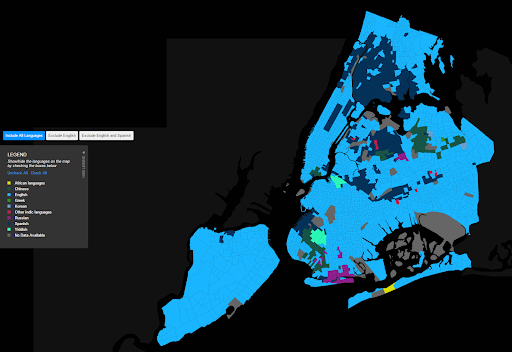Over 800 languages are spoken in New York City, making it the most linguistically diverse city in the world.
That’s more languages than there are countries on Earth! While English is the official language and the most widely spoken, nearly 40% of New Yorkers speak a language other than English at home.
But what are the top 4 languages you’re likely to encounter while navigating the city’s vibrant streets and diverse neighborhoods?
That’s where our guide comes in. “Top 4 Languages of New York” is your key to understanding the city’s rich cultural tapestry.
We’ll delve into the origins, cultural significance, and neighborhoods where each of these languages thrives.
English is Equal to New York
English, the undisputed king of communication in New York City. It’s the language of commerce, government, education, and everyday life.
From street signs and subway announcements to business meetings and casual conversations, English is the glue that binds together the city’s diverse population.
As of the 2020 census, a staggering 71.5% of New York City’s residents speak English at home, a testament to its ubiquity and importance in daily life.
Whether you’re hailing a taxi, ordering a bagel, or navigating the intricate subway system, a grasp of English will undoubtedly serve you well.
While some might argue for its official status, it’s undeniable that English is the de facto language of New York City. It’s the language you’ll need to navigate the city’s vibrant streets, engage with its diverse communities, and fully experience its rich cultural offerings. As such, it serves as the baseline for our exploration of the city’s linguistic diversity.
So, while English may not be included in our ranking of the top 4 most spoken languages in New York City, its importance is paramount.
With over 5.5 million speakers in the city, it’s the linguistic key that unlocks the city’s secrets and allows you to fully immerse yourself in its unique cultural tapestry.
To help you navigate US accen English, consider platforms like AmazingTalker, which connect learners with expert New York English tutors for personalized language lessons. But remember, while English may be the common thread, it’s the vibrant hues of other languages that truly make New York City a global melting pot. So, let’s explore the top 4 most spoken languages after English that contribute to this city’s unique cultural identity.
Top 4 Languages
Spanish
Spanish is the second most spoken language in the city, with an estimated 2.3 million speakers, making up nearly 29% of the population. This linguistic tapestry weaves through every borough, but its presence is particularly strong in neighborhoods like Washington Heights in Manhattan, Bushwick and Sunset Park in Brooklyn, and East Harlem, affectionately known as Spanish Harlem or El Barrio.
Spanish has left an indelible mark on New York City’s cultural landscape. From the sizzling flavors of mofongo and paella to the infectious beats of Latin music, the Spanish influence is palpable.
Festivals like the Desfile Nacional Puertorriqueño (National Puerto Rican Day Parade) and the Carnaval de Sunset Park showcase the vibrant traditions and cultural pride of the city’s Hispanic communities.
Spanish-language media outlets, theaters, and cultural institutions further enrich the city’s cultural fabric, offering a window into the diverse experiences and perspectives of its Spanish-speaking residents.
The roots of New York’s Spanish-speaking community trace back to the early 20th century, when waves of immigrants from Puerto Rico, the Dominican Republic, and other Latin American countries arrived in search of economic opportunity and a better life.
Over time, these communities established themselves in various neighborhoods, creating vibrant enclaves where their language, culture, and traditions could flourish.
Chinese
In New York City, the sounds of Mandarin and Cantonese weave a rich tapestry of Chinese heritage and culture. With an estimated 629,000 speakers, Chinese is the third most spoken language in the city after English and Spanish.
While Mandarin is the official language of China and the most widely spoken dialect globally, Cantonese holds a special place in the hearts of many New Yorkers of Chinese descent, often serving as the language of heritage and tradition.
Chinese culture’s impact on New York City is undeniable. Festivals like the Lunar New Year and the Dragon Boat Festival draw crowds from all walks of life, showcasing the rich heritage and vibrant traditions of the Chinese community.
Russian
The sounds of Russian resonate through several neighborhoods in New York City, a testament to the waves of immigration from the former Soviet Union. Brighton Beach, often referred to as “Little Odessa,” is a vibrant hub of Russian culture, where the aroma of borscht fills the air and the Cyrillic script adorns storefronts. Here, Russian is the language of daily life, spoken in homes, businesses, and community centers. Sheepshead Bay and Coney Island also boast significant Russian-speaking populations, contributing to the city’s diverse linguistic landscape. Similarly, the importance of language immersion is evident in other cities around the world, such as in Spanischunterricht in Havanna, Kuba, where language learning thrives through direct cultural engagement, offering students an authentic experience of the local language and culture.
Beyond language, Russian culture has left an indelible mark on New York City. Russian delis and bakeries offer a taste of traditional flavors, while Russian bathhouses provide a unique cultural experience. The annual Brighton Beach Festival celebrates Russian heritage with music, dance, and food, drawing crowds from across the city. Russian-language media outlets and cultural institutions further strengthen the community’s connection to its roots, providing a platform for cultural expression and preservation.
Yiddish
Once the language of Jewish immigrants from Eastern Europe, Yiddish has a long and rich history in New York City. While its prevalence has diminished over time, it remains an important part of the city’s cultural fabric. Neighborhoods like Borough Park and Williamsburg in Brooklyn are home to thriving Hasidic communities, where Yiddish is spoken in homes, schools, and synagogues.
The legacy of Yiddish extends beyond these enclaves, however. Its influence can be felt in the city’s culinary scene, with iconic dishes like bagels and lox, knishes, and matzo ball soup tracing their roots to Jewish immigrants from Eastern Europe. Yiddish theater, music, and literature have also enriched the city’s cultural landscape, offering a glimpse into the lives and experiences of Jewish New Yorkers. While Yiddish may not be as widely spoken as it once was, its cultural significance remains undeniable, a reminder of the city’s rich and diverse history.
Wrap Up
To truly understand the linguistic landscape of New York City, it’s essential to delve into its rich history of immigration. The city’s roots as a melting pot can be traced back to the early 17th century when Dutch settlers established New Amsterdam, which later became New York City. Subsequent waves of immigration from Europe, Asia, Africa, and Latin America have shaped the city’s diverse cultural fabric, bringing with them a plethora of languages and traditions.
From the Irish and German immigrants of the 19th century to the Italians and Eastern Europeans of the early 20th century, each wave of newcomers has left its linguistic mark on the city. More recent waves of immigration from Latin America, Asia, and Africa have further enriched the city’s linguistic tapestry, creating a vibrant and dynamic cultural mosaic.
Numerous language schools, cultural centers, and online platforms offer courses in everything from Spanish (“Spanish classes near me” is a great search term to get you started) and Mandarin to Russian and Yiddish.




